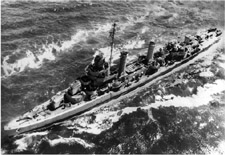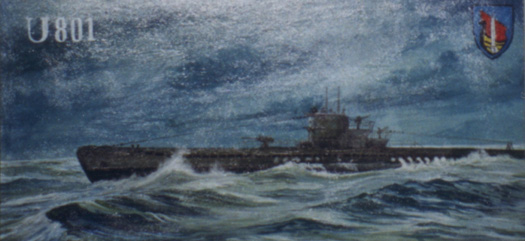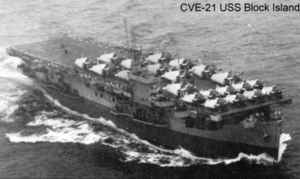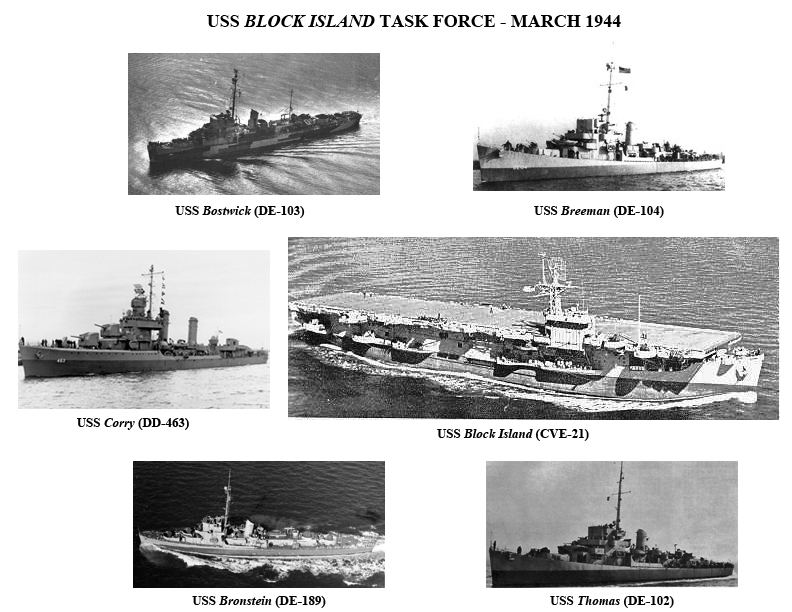|
From: http://www.history.navy.mil/danfs/b7/block_island-i.htm
February - March
1944
For her third Atlantic combat cruise, Block Island sailed with a
different screen, Escort Division (CortDiv) 48 comprising four new destroyer-escorts -- Bronstein
(DE-189), Bostwick (DE-103), Breeman (DE-104) and Thomas (DE-102)--and the new
destroyer Corry (DD-463). [DD-463 was the second USS Corry.]
Composite Squadron 6 reported on board for the cruise, equipped with new Grumman
FM-2 "Wildcat" fighters in addition to its "Avenger" complement. Also new on
board was Capt. Ramsey's relief, Capt. Francis M. Hughes.
AIRCRAFT ABOARD THE USS BLOCK ISLAND
|
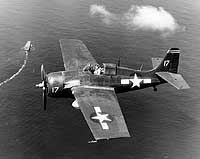
Grumman FM-2 "Wildcat" Fighter |
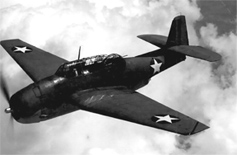
"Avenger" Torpedo-Bomber Fighter |
Departing Norfolk on 16 February
1944,
Block Island and her consorts did not see significant action until entering the "Black Pit"
almost two weeks later. Three minutes after midnight on 29 February 1944, Block Island's
"huff-duff" (high-frequency direction finder) locked onto an enemy transmission, and the task group
altered course to pursue. Nine minutes later, Bronstein made an inconclusive "hedgehog"
attack on the contact; and, after dawn, hunter-killer teams of "Wildcats" and "Avengers"
scoured the area intensively. The search took all day, but persistence paid dividends. In the waning light of
day, Lt.(jg.) Norman T. Dowty sighted a periscope feather wake. He and his wingman, Lt.(jg.) William H. Cole
circled, and Dowty swept in for a mine run. They dropped a sonobouy and verified the U-boat's presence as
Corry sped to the scene from 15 miles away. Then, dusk and nearly empty fuel tanks compelled the pair
to return to the carrier.
As it turned out,
Block Island's task
group had come across a gathering of four U-boats -- U-709, U-603, U-607 and U-441. In the ensuing night-long melee, fought by the escorts, Bronstein killed U-603 with an 18-depth charge pattern that blew the U-boat apart, and then teamed with Thomas and Bostwick to sink U-709. Finally, though not sunk, a badly battered U-441 limped into Brest 14 days later. While Capt. Ramsey estimated that between five and seven U-boats had been in the vicinity that wild night, postwar analysis of the records revealed that Block Island had been within 25 miles of at least 15 U-boats -- all part of a group just deployed in a 100-mile long crescent. With orders to arrive in Casablanca on 8 March, Capt. Ramsey took Block Island and her consorts into port for replenishment and a brief rest, during which he turned over command to Capt. Hughes.
On 11 March, the carrier and her escorts put to sea to track down a
"milch cow" [supply sub] northwest of the Cape Verde Islands -- U-488, ironically the U-boat that she had
attacked the previous October. Steaming southwest, Block Island sent hunter-killer teams ahead to hunt
for the other submarine believed to be headed for the rendezvous indicated in the intelligence reports. This
boat, U-801, was totally unaware of Block Island's approach of as she completed surface gunnery
practice late on the afternoon of 16 March. Then, one of the Block Island hunter-killer teams, Lt.(jg.) Charles Woodell's "Avenger" and Lt.(jg.) Paul Sorenson's "Wildcat," rudely cut short her drills. Sorenson strafed the surfaced sub, observing hits at the base of the conning tower and inside the bridge while the U-boat's surprised crew scrambled for shelter. After Woodell aborted a bombing run, Sorenson came in for a second strafing run, noticing that fire had broken out on the bridge, apparently from exploding ammunition and burning deck planking. Woodell then made his second pass, loosing two depth bombs which overshot the submarine as she submerged at 1728. At that point, the American planes dropped sonobouys which clearly showed the submarine's track. Planes covered the area for two hours but were then recalled. U-801 surfaced cautiously to report that she had been attacked and damaged, whereupon the command at Brest set up a rendezvous with U-488 -- Block Island's original target!
After the radio exchange with Brest, U-801 detected approaching
aircraft and "pulled the plug." A search plane covered the area for a while around nightfall but
sometime between the plane's departure and Corry's arrival, U-801 managed to surface and
recharge her batteries for two hours without being detected. Only then did the Germans discover that they
trailed a tell-tale oil slick.
As Corry arrived in the area to hold down the U-boat, Block
Island launched Lt.(jg.) Dowty at 0210 to pursue a "huff-duff" fix obtained on the transmitting
submarine only 45 miles away. Dowty met up with Corry and commenced an expanding search. His radar
picked up a contact almost immediately, and he dropped down to attack only to see the U-boat submerge. While
Corry spotted and destroyed the radar decoys U-801 had left scattered on the surface, Dowty
located the wake of a periscope and dropped a mine on the swirl. He dogged U-801's trail for the rest
of the night, and dawn rewarded him with the sight of an oil slick meandering off into the distance. Low on
fuel, Dowty alerted Block Island and then returned to her after a fresh plane relieved him.
Meanwhile, Bronstein had joined Corry; but neither they nor
the plane could locate the oil at first. Finally, at 0900, the new "Avenger" picked up the scent
again, dropping a string of float lights to mark the spot. Corry and Bronstein then picked up
the contact; and the destroyer attacked at 0942, her depth charges opening a seam in U-801's hull and
forcing her skipper to dive deeper. For an hour, the U-boat evaded the attacks, but she continued to leak oil. Around 1140, Corry dropped another pattern of depth charges, and this one proved decisive. With bilge pumps and some switchboards knocked out and her periscope's power having failed, the submarine could not mount a submerged defense, so she had to come up. U-801 lurched to the surface as Block Island, screened by Thomas and Breeman, arrived to witness the last act of the drama.
Warning off the "Avenger" overhead as it dove toward the sub,
Corry and Bronstein opened fire with 5-inch, 3-inch, and automatic weapons.
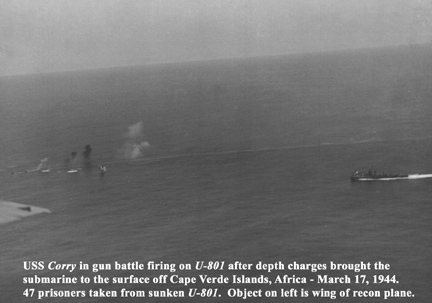
The heavy fire
killed the U-boat's captain and warrant quartermaster as soon as they gained the open bridge. Those who
followed wasted no time in abandoning ship. Corry and Bronstein, cheered on by
Block Island's crew thronging her flight deck, methodically reduced U-801 to junk; and, at
1226, the badly battered U-boat sank. The two warships then moved through the oily water to recover two
officers and 45 enlisted men--a remarkable number considering the hail of gunfire through which they had
passed. That afternoon, Corry transferred all 47 to Block Island by breeches buoy.
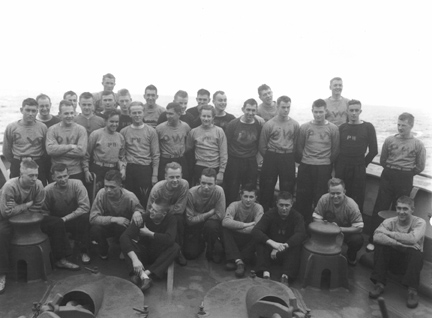
U-801 Enlisted Men POWs
The original object of the search, however, U-488, had yet to be
found. The task group scoured the sea during daylight on the 18th and then shaped a southwesterly course that
night in the hope of locating another south-bound submarine. Six hunter-killer teams launched at dawn on 19
March fanned out from the warship and covered the area within a 150-mile radius. At 0726, Lt.(jg.) Cole, in
his "Wildcat", spotted a submarine ahead, to port of his heading. Flying with the early morning sun
at their backs, Cole and Lt.(jg.) Dowty, had surprised the Germans completely. The new 1,100-ton U-1059
lay dead in the water while her captain, Oberleutnant zur See Günter Leopold, joined many of his crew in a morning swim.
Cole swept around the U-boat's stern to come up on the port quarter and
allow Dowty, in the slower "Avenger," to move in directly on her starboard quarter. Cole triggered
his six .50-caliber machineguns and shot up the submarine's decks, his bullets striking home among the German
sailors being rousted out of their morning relaxation. Some, however, managed to get the antiaircraft guns
into action by the time Dowty dropped down to deliver his depth-charge attack and got off a few bursts from
the 20-millimeter and 37-millimeter guns as the "Avenger" roared low over their heads.
Dowty's charges burst in textbook fashion, straddling U-1059, and an
enormous explosion cleaved the submarine in two. Cole banked around for a strafing run but quickly saw that
no useful target presented itself. The two broken sections of the U-boat settled while a pitifully small
group of men struggled in the water outside a mass of flame and smoke. Dowty, too, banked around in a sharp
turn for another run; but he either lost control or his engine failed. The "Avenger" dropped one
wing and spun into the ocean a short distance from her kill. Dowty and his radar operator never got out of
the sinking plane, but a third occupant just "along for the ride" -- Ens. Mark Fitzgerald --
managed to free himself and grab a life raft before the plane sank.
Cole, circling overhead, reported the crash and the lone survivor,
and Corry rushed to rescue him and the few Germans who remained. Cole counted about 15 Germans in the
water at first, but the number declined steadily during the two hours that passed before
Corry arrived. In
the meantime, Ens. Fitzgerald inflated the raft and used it to rescue two of the Germans himself -- a
severely wounded sailor and the U-boat's equally badly injured commanding officer. When she arrived,
Corry rescued this trio and then picked up six more Germans about a mile away. The task group cruised
the area for several days and attacked two underwater contacts -- both apparently non-submarine -- before
heading back to Norfolk where it arrived early on 31 March.
With seven wounded prisoners from U-1059, USS Corry departed the task group and headed for Boston,
arriving there on 30 March 1944.
Note: Aircraft carrier USS Block Island (CVE-21) was torpedoed and
sunk on 29 May 1944 by U-549. |
